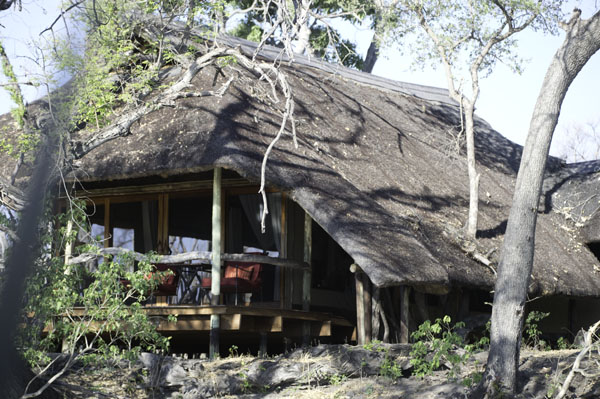 The four camps we visited were "Kalahari Plains" for two nights, and then three nights each at "Chitabe," "Xigera," and "Savuti." On the left is a photo of our tent cabin at Xigera.
The four camps we visited were "Kalahari Plains" for two nights, and then three nights each at "Chitabe," "Xigera," and "Savuti." On the left is a photo of our tent cabin at Xigera.
Want to send me mail? Click here: tomrdavis@earthlink.net.
Return to my main Botswana photo page.
 My wife and I wanted a great trip to Africa, and since my she had just retired, we were willing to splurge to celebrate, so we did not try to travel on a tight budget. We wanted great wildlife viewing and photography opportunities and since we are interested in almost any kind of animal, we wanted to be sure to see and try to photograph a wide variety of animals; not just the big mammals for which Botswana is famous. We also wanted to see sunsets like the one on the right.
My wife and I wanted a great trip to Africa, and since my she had just retired, we were willing to splurge to celebrate, so we did not try to travel on a tight budget. We wanted great wildlife viewing and photography opportunities and since we are interested in almost any kind of animal, we wanted to be sure to see and try to photograph a wide variety of animals; not just the big mammals for which Botswana is famous. We also wanted to see sunsets like the one on the right.
We also wanted to have as many of the logistics as possible taken care of for us: we didn't want to rent a car, find our own meals, et cetera. We just wanted to spend as much time looking for and photographing animals as possible.
Finally, we wanted to go at the best time of year to see the animals, and for most of the sites in Botswana, that meant in September or October.
It sure took more than a day to get to Botswana: We started in the late afternoon, flew overnight to Frankfurt, Germany, then had a 7-hour layover for which we used our frequent flyer miles to rent a room in the airport hotel for a shower, nap and rest. Then we flew to Johannesburg, South Africa, arriving at about noon, and we spent another night there. We then flew in the morning to Maun, Botswana, then got in a small bush plane to a tiny airport, and finally arrived at the lodge in time for an afternoon "game drive."
We've got some good friends from the Stanford biology department who have been to Africa many times and to many countries so we went to them for advice. They said that if we only visited one country, Botswana was the best, since the country is very stable politically, quite safe, and the wildlife (which was our main reason for visiting) is fantastic. In fact, they said that the previous year they'd taken a great trip and shared their itinerary with us where they had visited four camps in Botswana that were all basically in and around the Okavango delta. We decided to do almost the same thing, but we omitted one of the camps they visited and added a different one of our own since we wanted to see the Kalahari Desert.
 The four camps we visited were "Kalahari Plains" for two nights, and then three nights each at "Chitabe," "Xigera," and "Savuti." On the left is a photo of our tent cabin at Xigera.
The four camps we visited were "Kalahari Plains" for two nights, and then three nights each at "Chitabe," "Xigera," and "Savuti." On the left is a photo of our tent cabin at Xigera.
We were lucky that we asked for advice when we did: we wanted to go at the optimal viewing time, and that turned out to be about nine months from when we decided to go. With that much lead time it was pretty easy to get reservations in exactly the camps we wanted. Apparently, if you try to book a last-minute trip, at lot of the lodges are completely full.
We arranged all our travel using the company Geographic Expeditions in San Francisco. All the camps were run by an organization called Wilderness Safaris which was very convenient, since all the lodges are synchronized relative to activities and transportation.
We were certainly happy with the results: we made every connection and we were totally taken care of.
Since it generally gets pretty hot in Botswana in the summer (which occurs in September/October south of the equator) being out in the middle of the day is pretty miserable. At every lodge we visited, the routine was about the same: up early (5 to 6 am, depending) a quick breakfast, and then the morning activity would begin. That activity continued until about 11 am, with a break for "tea" in the field at 9:30 or so. We'd then have lunch at the lodge, and then we were off until about 4 pm for a second "tea" at the lodge followed by the afternoon activity. When the sun was almost down, we'd have a "sundowner" involving alcohol, usually in the field, and then back to camp, followed by dinner at 7:30 or 8:00.
 Of course at the two teas and sundowner (a photo of a typical tea appears on the right), there was always some finger food, so with the usual breakfast, lunch and dinner, we basically ate six meals per day. It's also impossible to get much exercise, since, due to the danger of lions, leopards, hippos, elephants, et cetera, it's far more dangerous to be out in the open in the bush in Botswana than anywhere in Central or South America. In fact, at the lodges where we stayed, before sunrise or after sunset we were required to walk between our cabins and the main lodge only when accompanied by a lodge staff member. In every one of the camps where we stayed the passageways connecting all the buildings were on walkways supported a meter or so above the ground.
Of course at the two teas and sundowner (a photo of a typical tea appears on the right), there was always some finger food, so with the usual breakfast, lunch and dinner, we basically ate six meals per day. It's also impossible to get much exercise, since, due to the danger of lions, leopards, hippos, elephants, et cetera, it's far more dangerous to be out in the open in the bush in Botswana than anywhere in Central or South America. In fact, at the lodges where we stayed, before sunrise or after sunset we were required to walk between our cabins and the main lodge only when accompanied by a lodge staff member. In every one of the camps where we stayed the passageways connecting all the buildings were on walkways supported a meter or so above the ground.
But none of the camps had any fencing, and once we had a long wait during the day on the passageway to our cabin since there was an elephant right up against it. I guess visits by elephants are fairly common, but at one of the camps, in the evening, we saw a leopard using the walkway himself.
The synchronization of the activities made it easy to vist a bunch of different camps and not miss anything. Typically, you'd fly to the local bush airport on a small plane in the middle of the day where you'd be met by your guide in a Range Rover. Then it was usually about a half hour to the camp, but the guide would of course stop if there was anything interesting to see. (Usually not much, however: most of the animals also have the good sense not to be out in the hottest part of the day in the summer.) You'd get to the camp, have a lunch if you'd missed it at the previous camp, and then you had time to settle in and be ready for the afternoon tea and activity.
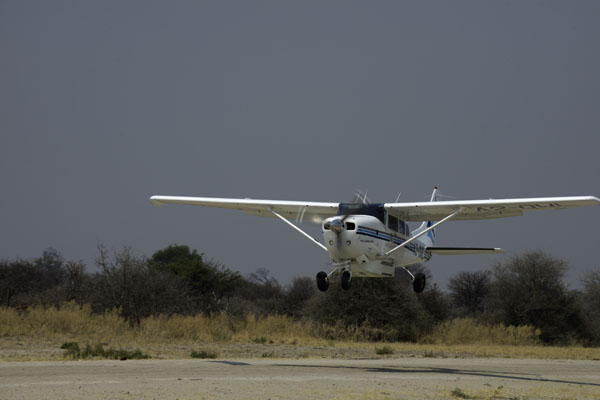 On the left is a photo of one of the larger bush planes. At your last day at a camp, you'd do the morning activity, possibly have lunch, and then be driven to the local bush airport to fly to the next camp (or to Maun, if you were heading home). That way, you got your two full activities every day. Of course you could skip them if you wanted to be lazy, but we certainly didn't want to miss anything while we were there.
On the left is a photo of one of the larger bush planes. At your last day at a camp, you'd do the morning activity, possibly have lunch, and then be driven to the local bush airport to fly to the next camp (or to Maun, if you were heading home). That way, you got your two full activities every day. Of course you could skip them if you wanted to be lazy, but we certainly didn't want to miss anything while we were there.
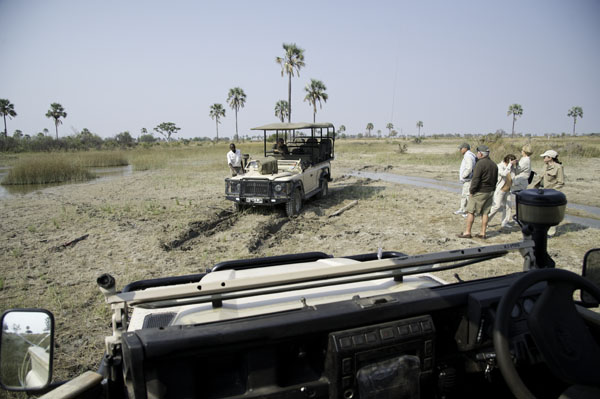 The most common activity was a "game drive" where you'd ride around in a Range Rover (on the right is a photo of one that's stuck in the mud), looking for stuff. Since it wasn't a budget trip, we paid extra, wherever possible, to be in a private vehicle. That way, since we are far more interested in birds than the average safari goer, we could stop for a good look at even the "little brown birds" -- LBBs (or "little brown jobs" -- LBJs in British English) without having a conflict with other Range Rover mates who might only be interested in the large mammals, or who had no interest in photography and would be happy with a snapshot of a leopard. When I saw something cool, I'd sometimes take 100 or more photos.
The most common activity was a "game drive" where you'd ride around in a Range Rover (on the right is a photo of one that's stuck in the mud), looking for stuff. Since it wasn't a budget trip, we paid extra, wherever possible, to be in a private vehicle. That way, since we are far more interested in birds than the average safari goer, we could stop for a good look at even the "little brown birds" -- LBBs (or "little brown jobs" -- LBJs in British English) without having a conflict with other Range Rover mates who might only be interested in the large mammals, or who had no interest in photography and would be happy with a snapshot of a leopard. When I saw something cool, I'd sometimes take 100 or more photos.
At the first camp, at Kalahari Plains, there were no private vehicles available so we shared one with a wonderful couple from Switzerland who were on their honeymoon. We couldn't have picked a better pair to travel with. But we're still glad we had the private vehicles at the other camps, since there were a few sets of people we met with whom sharing a ride would have been difficult. In fact, we met the Swiss couple at our third camp, Xigera, and since we controlled our vehicle, we could invite them to come with us.
With the private vehicle, we could also spend a lot of time maneuvering around interesting birds and animals, trying to get them in the best light, with no branches in front of them, et cetera. Also, even with game drive mates who are cooperative, if there are six or seven people in a vehicle, unless they are all photographers, somebody is usually moving around, causing a bit of camera shake.
At each of the camps where we stayed, the guides in the vehicles were in constant communication and if one guide found something interesting, he'd let the others know by radio and if another car was close enough and interested, they could come and see the same thing.
Of course all the guides knew where the last sighting of most of the interesting animals was, so if you wanted to see a lion or a leopard, for example, at least the search could begin where it was seen one or a few days before. One thing that really impressed me about the guides is their ability to read the animal tracks on the dirt roads and figure out how long ago the animal had been there, what direction it was moving, et cetera.
At the Wilderness Safaris camps there's a rule that at most three vehicles can be present at any animal sighting. Apparently at other camps you'll sometimes have a dozen vehicles surrounding the poor lions or leopards. In addition to annoying the animals, it also annoys the photographers since the presence of so many vehicles makes it impossible to get a photo that omits all the other vehicles.
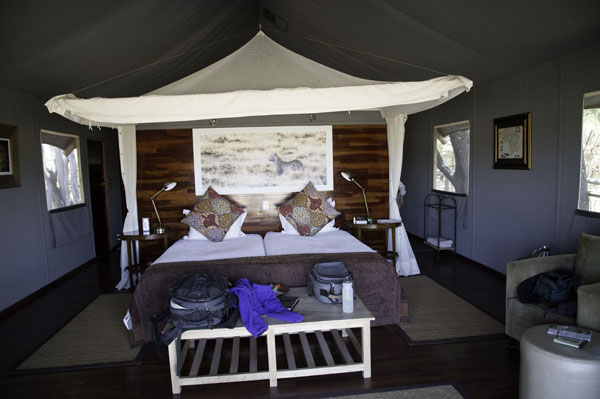
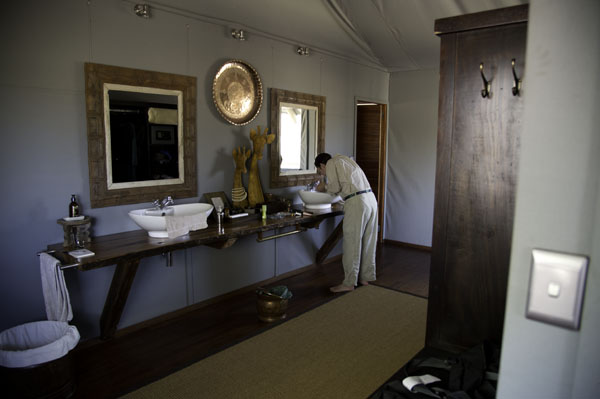
Above are photos of the inside of one of our rooms. Apparently the photographer must have been a bit drunk when he took the upper photo since the floors of the cabins were all level, not tiled by 15 degrees.
 If there were rivers at the site (which there were for us except in the Kalahari Desert), another option for an activity was to go on a boat ride and we did that at least once at each of the other three sites. Depending on where you were, there were other activities as well. At the Kalahari Plains camp we went on a "Bushman Walk" where we hiked around with a real bushman who showed us how they obtain food, make shelters, and make fire. At Xigera camp, at far end of a boat ride we were in a "lagoon" were we could actually (safely) swim. Most camps also have activities aimed at families with kids who easily get bored on a standard game drive and who can't participate in the "sundowner." The photo on the right shows the process used by the bushmen to make a fire.
If there were rivers at the site (which there were for us except in the Kalahari Desert), another option for an activity was to go on a boat ride and we did that at least once at each of the other three sites. Depending on where you were, there were other activities as well. At the Kalahari Plains camp we went on a "Bushman Walk" where we hiked around with a real bushman who showed us how they obtain food, make shelters, and make fire. At Xigera camp, at far end of a boat ride we were in a "lagoon" were we could actually (safely) swim. Most camps also have activities aimed at families with kids who easily get bored on a standard game drive and who can't participate in the "sundowner." The photo on the right shows the process used by the bushmen to make a fire.
Another activity that we didn't try was just to sit in the bar, or to sleep. In fact, I did take a nap almost every day, but it was always during the hot middle of the day between the morning and afternoon activities, especially if I'd had a beer for lunch. But mostly we went on game drives.
At the end of each activity, I would copy all the day's photos to a laptop and if there was time, I'd also look through the photos to see how well I'd done. I brought enough memory cards that I never erased them so I effectively had a backup of every photo. And there were a lot of photos: I took about 5700 of them during the entire trip.
We were on the verge of not taking any medication, but Ellyn's friend is a physician who does a lot of work in the travel medicine area and she suggested that we take it, since malaria is such bad news and since the strains of malaria present in Africa tend to be the nastiest. So we decided to take Malarone: one pill every day, starting a day or two before you go on safari, and for one week after you return.
My strategy for remembering to take the pill was to take it at breakfast so that if I forgot, at least I had the entire rest of the day to remember. Ellyn has a better memory than I, so she just took hers at dinner every night. (It's supposed to be taken with food.)
But the easiest strategy is simply not to get bitten by mosquitos. We took DEET with us and all the camps provided additional DEET in case you didn't bring any. But we also used Permethrin which you spray on your clothes and after it dries it will repel mosquitos (and lots of other insects and arachnids). We wore treated long-sleeved shirts and long pants, socks and a hat every day and I don't think either of us got a single bite. One treatment of your clothes with Permethrin lasts through 20 or so washings. According to Wikipedia, Permethrin seems to be pretty safe for humans.
I had personally run a couple of "experiments" with Permethrin in the tropics of South America, and I always use it as a result of those experiments. Once on a volunteer bird-banding trip to Ecuador I had treated my clothes but it was so hot I didn't wear the treated shirt and instead spent a couple of days in treated pants and an untreated T-shirt. At the end I had a couple of bites below the waist and perhaps 100 above the waist.
Another time, bird-watching in Brazil, our guide took us to a place where we were warned that there were a lot of ticks. I had treated pants but I had not sprayed my socks or shoes, so I stuffed my pants into my socks, which is never a bad idea when there are a lot of creepy-crawly things about. After walking around for a short time, I looked at my feet and both my shoes and socks were literally seething with ticks -- hundreds and hundreds of them. But as they climbed my socks and onto my pants they would drop off after just taking a few steps.
Visit my Home Page.
Want to send me mail? Click here: tomrdavis@earthlink.net.